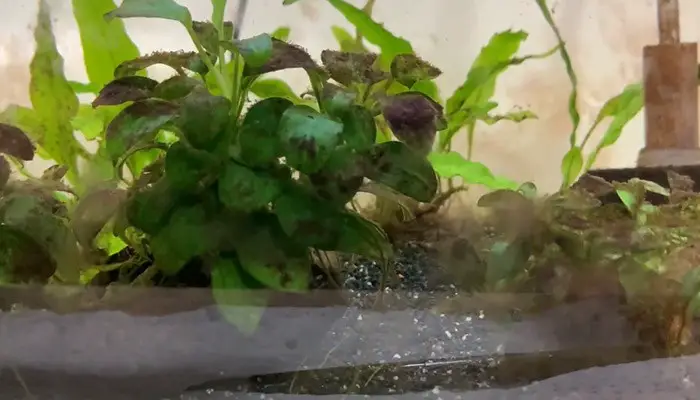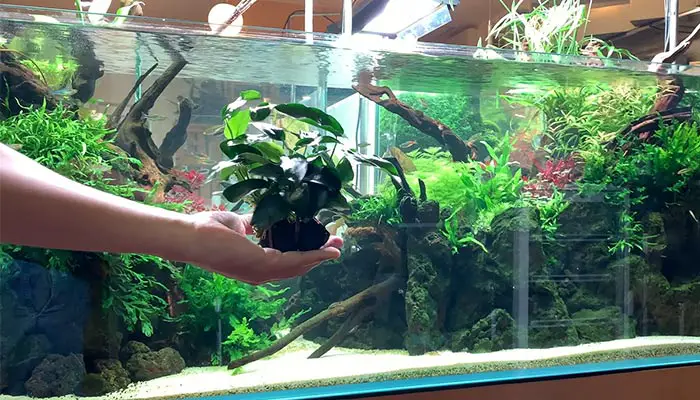5 Reasons for Anubias Leaves Turning Brown [How to Fix]
To increase the greenery in your aquarium, Anubias is one of the first choices. It is known as a herd immune plant. Thus Anubias leaves turning brown raises concern.
There are several reasons why Anubias change color. And some vital reasons are nutrient deficiency, inadequate light, and carbon dioxide, affected by brown algae, aging, etc. All these reasons are concerning. But with the proper effort, it can be resolved.
To keep Anubias revived it is important to take care of the plant even though it is an easy-going plant. Also having Anubias in the aquarium not only enhances the beauty but is also good for your aquarium.
Why Anubias Turning Brown And Solutions

1. Deficiency Of Nutrients
The deficiency of nutrients like magnesium potassium and iron causes the change in color of Anubias leaves. First, it turns color to yellow and slowly turns to Brown. There will be brown spots here and there rather than the whole leaf.
Read More- 4 Causes of Amazon Sword Turning Yellow -Effective Solutions
When the whole leaf tends to change color, the change will begin at the tip of the leaf and spread to the apex. Sometimes nutrient deficiency can also cause black spots in the leaves.
Solution
The only solution to the deficiency of nutrients is to supply fertilizer in the aquarium. You will need to ensure that the fertilizers you’re using have the proper balance of macro and micronutrients. (Our Pick: API PONDCARE AQUATIC PLANT FOOD TABLETS Potted Plant Fertilizer)
Also to give better nutrition you have to ensure that there are no parasitic plants around the Anubias plant. Pick up the parasitic plants with clams.
2. Brown Algae
An outbreak of brown algae is another reason why Anubias leaves turn brown. It mainly happens when the plant is shifted to another tank or the water is replaced. At the time there was a deficiency of nitrate that helped in the growth of brown algae.
Even though this algae doesn’t harm the plant and is a food supplement for your aquarium fish. But they don’t give a good look at the plant. It gives a dusky shade to your dark Green Leaves of Anubias.
Solution
There is no need to worry about removing the brown algae. The more the aquarium settles, the brown algae diminishes. The proper amount of nitrate and ammonia will remove the brown algae from the Anubias and you will get back the deep green color of the leaves in no time.
Remember not to use any special fertilizer to remove the brown algae. As they can be healthy for some of your aquatic plants.
3. Deficiency Of CO2
When you see that the plant’s leaves are turning brown slowly and it spreads to the stem, then it is caused by the deficiency of carbon dioxide. The deficiency of carbon dioxide can be serious. It will end up killing most of the plants in the aquarium along with the Anubias.
The deficiency of carbon dioxide makes the plant weak. You will see that most of the plants in the aquarium will lose strength and herbs.
Solution
The problem of carbon dioxide deficiency is a severe issue that needs immediate attention. For this, it is important to use a water-soluble fertilizer. It needs to be used regularly.
You can also balance the light on and off during the day and night to release carbon dioxide from the plants. It will help to make a balance without external fertilizer.
You can also choose slow-growing plants for your aquarium which need to use less carbon dioxide. Besides, make sure to remove any bubbling device from the aquarium.
While balancing carbon dioxide be careful. Because it can temper the pH balance. Therefore always keep an eye on the pH meter. (Our Pick: Ruolan PH Meter for Water Hydroponics)
4. Inadequate Lighting
Even though Anubias are quite adjustable to different typical situations, in adverse situations, they need well-balanced lighting. Otherwise, it will mess up the photosynthesis process. If the place of the aquarium does not have access to adequate sunlight then the Anubias tend to change color.
Solution
The only solution to inadequate lighting is to provide a proper lighting system. If your place can’t access proper sunlight then do not worry. Nowadays there are several lighting systems available. (Our Pick: hygger Clip On 24/7 Lighting Aquarium LED Light)
These lights help plants in photosynthesis. But with these lights, you will need to balance the on-and-off cycle. For these get to learn about the photosynthesis cycle.
5. Plants Getting Old
When Anubias gets old, it tends to change its color from green to yellow and yellow to brown. Especially the older leaves near the roots will change color before the new leaves. The color-changing process will be slow.
Solution
When plants get old, you will need to get rid of the old leaves. This will ensure that the plant revives a bit. But if the whole plant is already brown and dead, it needs to be replaced.
With the help of your aquarium tool, pick out the dead plants and replace them. While replacing make sure the new plants are young and healthy.
Why Put Anubias In Aquarium

Anubis is one of those plants which can survive in different types of water conditions. Therefore it makes it more convenient to be used in aquariums. Here are some reasons why You should include Anubias as your aquatic plant.
Simple Care
For aquariums, it is always ideal to choose plants that are easy to care for. Especially for beginners. Anubis is one of the hardest plants. Therefore with minimal care, it thrives in the aquarium.
The plant also grows at a slowing rate. Therefore there is not much to worry about. All it requires is to trim it now and then.
Decoration
While decorating aquariums everyone wants to have a colorful vision. For this, a deep green Anubias is a perfect plant. It is thick and has an attractive green shade.
The color of the new leaves and the old leaves balances the color combination of your aquarium.
Plantation
For planting Anubias you do not have to worry about their placement. It is a very diversified plant that can be placed anywhere in the aquarium.
Anubias can be planted in the substrate of the tank. Also, it can be placed in any of the ornaments. You can use driftwood, rocks, or Coral as a medium for the plantation.
Keep The Aquarium Healthy
When in an aquarium both aquatic plants and animals stay side-by-side there has to be a balance of nutrients. Some nutrients are needed by aquatic plants but are harmful to fish or other animals.
Anubias is one of those aquatic plants that easily soak up ammonia, nitrate, nitrate, and nitrite. Therefore their concentration in the water of the aquarium is balanced and the aquatic animals don’t get hurt. It keeps the tank safe for other animals.
Maintenance Of Aquarium
Taking care of the aquarium is important so all other plants and animals along with Anubias stay healthy. These will help to achieve your aquarium goal.
- Put proper fertilizer into the tank. Must not use unnecessary chemicals.
- Balance the micro and macronutrients. The balance is very important.
- Check the pH balance from time to time.
- Ensure the aquarium is not affected by any microorganisms that can harm the plants. Use a proper water filter.
- Make sure the aquarium has proper lighting.
- Cover the aquarium properly in a way that it gets air but resists dust and debris formation.
- Clean the aquarium from time to time.
- Remove any parasitic plant that can suck up the other plants’ nutrients.
Frequently Asked Questions
How Many Hours Of Light Does Anubias Need?
Anubias inclines toward low lighting at under 3 watts for every gallon. Anyway, they can endure moderate lighting of 3-5 watts for every gallon. You should intend to give this plant between 8-9 hours of light every day. Since they needn’t bother with heaps of light a standard LED light installation is ideally suited for this plant.
Does Anubias Need Substrate?
While aquarium rock might be satisfactory, Anubias plants appear to improve when established in a supplement-rich substrate or when joined to permeable rocks or driftwood. Anubias plants can fill in aquarium rock, aquarium substrate, joined to rocks, driftwood, or adornments.
How Do You Feed Anubias?
Anubias takes nutrients for the most part from the water segment, so there’s no requirement for costly aqua soil. You can develop Anubias in the substrate by covering the roots and leaving the rhizome unburied.
What temperature should Anubias be?
Anubias can endure pretty much any sort of water hardness and pH levels; nonetheless, it will in general truly do best in delicate water with a pH of 6.5 to 7.5. It can likewise fill in a wide scope of water temperatures, yet we suggest keeping it in water that is somewhere in the range of 72° to 82° F for the best development results.
Final Words
The plants in the aquarium not only enhance the beauty. They also maintain an ecosystem of the aquarium. Similar Anubias play a vital role in this process. Therefore it is necessary to look for Anubias leaves turning brown. (Here is another article that may help- 5 Reasons For Java Fern Turning Brown)
If the problem is noticed in time, it can be solved in time. Otherwise, the plant will end up dying or may spread dullness.
- Top 10 Fastest Growing Aquarium Plants for a Thriving Tank - September 22, 2024
- 13 Freshwater Aquarium Ideas for Every Enthusiast - September 20, 2024
- Top 12 Red Aquarium Plants to Add Vibrancy to Your Tank - September 18, 2024
